Note: This website was automatically translated, so some terms or nuances may not be completely accurate.
INAX Live Museum: Putting "The Company as a Public Asset" into Practice
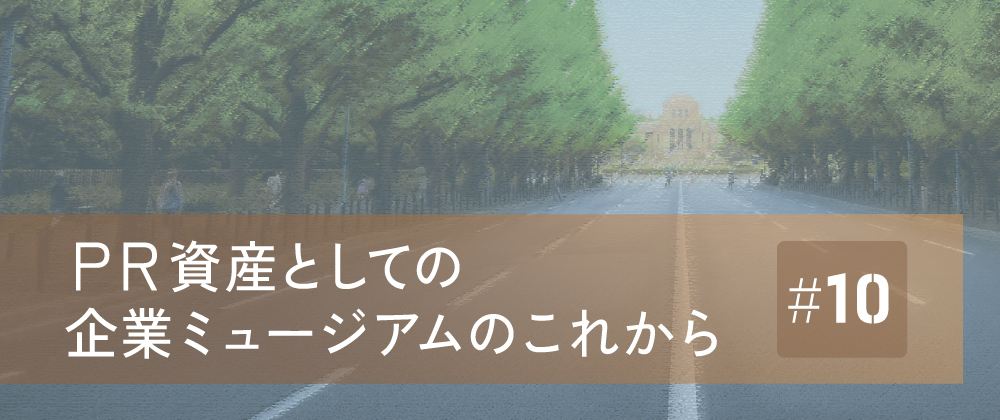
Corporate museums occupy a buffer zone spanning both the academic realm of "museums" and the business realm of "corporations." They are organizations that collaborate extensively with corporate departments such as public relations, branding, advertising, and human resources. In this series, PR professionals will introduce various museums operated by corporations, exploring their roles, functions, and potential.
Tokoname ware, originating from Tokoname City, Aichi Prefecture, is one of Japan's Six Ancient Kilns, with a history dating back to the Heian period. Building upon this foundation, INAX (now LIXIL) evolved from producing clay pipes to manufacturing tiles, sanitary ware, and other residential equipment. Through the "INAX Live Museum," which investigates, researches, restores, preserves, and exhibits valuable ceramics with a mission to pass on and evolve ceramic culture, we introduce the company's commitment to manufacturing that values learning from the past to create the future, and the museum's contribution to society.
Reporting and Text: Akemi Sakurai (PR Consulting Dentsu Inc.)

The INAX Live Museum traces its origins to 1986, when the "Kiln Square & Museum" opened as a cultural facility conveying Tokoname's modern industry, established by then-INAX President Teruzo Ina (honorifics omitted in text). This occurred the year after the company name changed from Ina Ceramics to INAX.
Founder Chozaburo Ina advocated that "a company is a public institution of society." This philosophy was passed down to his son Teruzo and materialized in the form of establishing a cultural facility. Following the opening of the "Square with Kilns and Museum," the facility was gradually expanded and grandly opened as the "INAX Live Museum" in 2006. Today, the vast 15,000-square-meter site houses six facilities: the Kiln Square & Museum, the World Tile Museum, the Birthplace of Architectural Ceramics Museum, the Clay & Mud Museum, the Tōraku Workshop, and the Pottery Workshop, along with a restaurant and museum shop.
The overarching theme is "Earth, Water, and Fire." Its concept is to be an experiential museum where visitors can see, touch, feel, learn about, and create the diverse world woven by earth and ceramics.
It serves as the central hub for the numerous Tokoname ware-related facilities scattered along the "Pottery Walking Path" extending from Tokoname Station. Before the pandemic, approximately 70,000 people visited annually, including local residents, general visitors, business partners, employees, and museum professionals. During the pandemic in 2021, approximately 50,000 people visited. This number rivals the population of Tokoname City, which is about 60,000. It is also utilized as a field trip destination for elementary and junior high schools, with an average of 4 out of the city's 9 elementary schools visiting annually.
For local residents, general visitors, and business partners, it fosters understanding of Tokoname City and LIXIL, a company dedicated to Tokoname ware and manufacturing. For other museum professionals, it serves as a venue for collaboration and exchange. For architects and designers, it provides a space for co-creation and challenge. For employees, it offers an opportunity to feel a sense of mission in creating homes for people's enriched lives and to take pride in their company.
"A company must be both an economic institution and a cultural institution."
The founding operating entity, INAX, merged with four other companies including Tostem in 2011 to become LIXIL, the industry's largest building materials and housing equipment manufacturer. Teruzao is known as the "revival founder of INAX" for spearheading its major transformation from Japan's top tile maker to a housing equipment manufacturer centered on sanitary ware, continuously introducing innovative products like the now-standard heated toilet seat. In 2022, he received the Architectural Institute of Japan Cultural Award for his "contributions to enhancing architectural culture through the collection and exhibition of architectural ceramics (tiles and terracotta) and for publicizing cultural value through book publishing."
"Teruzo Ina believed that a company's economic activities themselves must possess cultural significance," says Akemi Onouchi, the museum director who guided us on this visit. "For our company, which handles products closely tied to daily life and housing, it is vital that every employee, aiming to create products and provide services that contribute to enriching homes and lifestyles, possesses a deep interest and understanding of living and architectural culture."
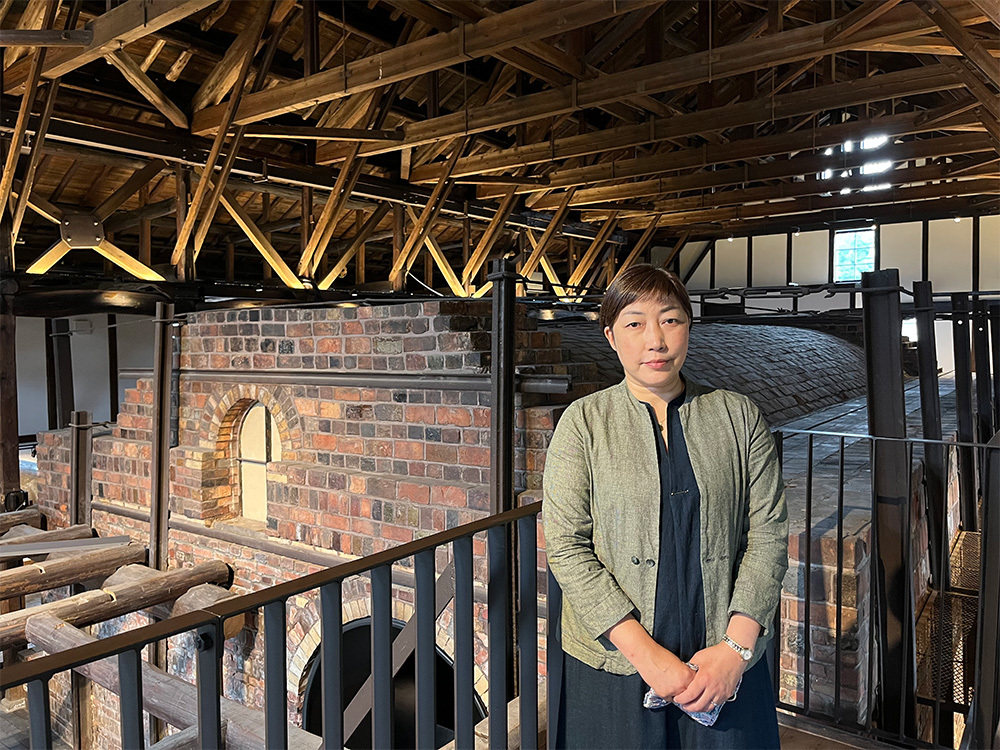
"The Square with Kilns & Museum" ~ Modernization and the Establishment of Clay Pipe Manufacturing ~
The first facility to open, "The Square with Kilns and Museum," was constructed in 1921 (Taisho 10) by the Kataoka Katsu Ceramics Factory. It operated until 1971 (Showa 46), manufacturing clay pipes, shochu bottles, and clinker tiles (thick, durable flooring). The adjacent INAX preserved and opened it to the public in 1986, later purchasing the site. The chimney, symbol of the Tokoname-yaki clay pipe factory, the brick kiln, and the building's roof structure using thick beams and pillars are of high architectural value. It is designated as a National Registered Tangible Cultural Property and a Modern Industrial Heritage Site.
Ceramics maintain consistent quality as long as they remain intact, free from cracks or chips. However, clay pipes used over long periods demand exceptional strength, durability, and precise specifications enabling seamless connections. Tokoname clay pipes were used for sewage lines buried in Yokohama's foreign settlement during the Meiji era, but initially, they were handmade, of poor quality, and prone to brittleness. After trial and error, mechanization advanced, leading to the production of robust, high-quality clay pipes. Ina Chozaburo spearheaded this mechanization and quality control.
Tokoname ware clay pipes were extensively used during Japan's modernization, supporting epidemic prevention, railway network expansion, infrastructure development like water and sewage systems, and drainage ditches that boosted rice production. They spread nationwide via shipping from the Chita Peninsula. Originating in the late Heian period, Tokoname ware evolved into industrial clay pipe manufacturing during the Meiji era, flourishing as a local industry.
"World Tile Museum" ~ Tiles Enhancing Hygiene Awareness and Residential Life ~
The World Tile Museum began in 1991 when tile researcher Masayuki Yamamoto donated his collection of approximately 6,000 tiles to Tokoname City. INAX undertook the research and analysis of this valuable collection, gathered by Mr. Yamamoto over 50 years of traveling the world, including the Silk Road. During this process, plans for the museum's construction took shape. It opened to the public in 1997, housing both the donated collection and INAX's own holdings.
Subsequent renovations enhanced visitor understanding and memorability by adding exhibits on regional culture, scientific underpinnings, and usage contexts, along with English explanations. Displays include a photograph of Vermeer's iconic painting "The Milkmaid" alongside painted tiles featuring the same motif as the skirting tiles depicted in the painting.

The background is depicted with meticulous detail. Dutch tiles are used on the skirting board. ⓒRijksmuseum, Amsterdam
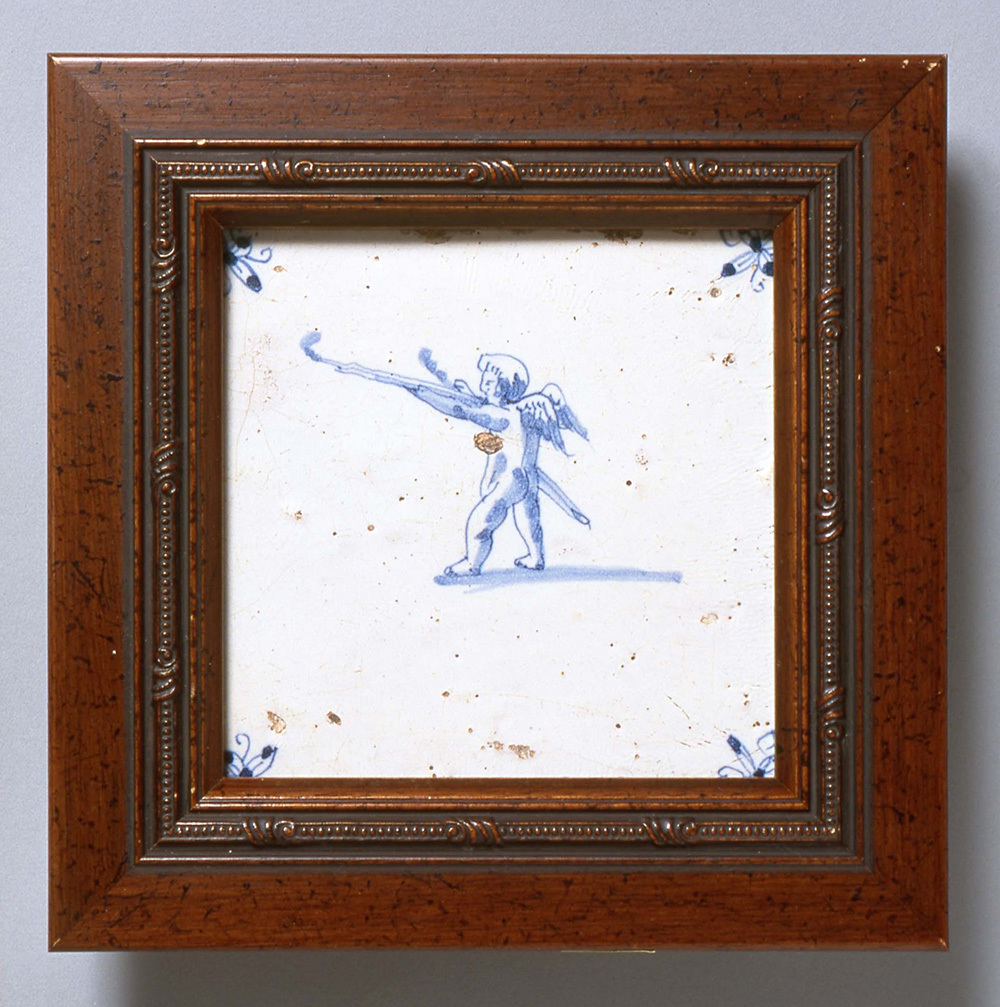
Here, blue tiles believed to be the oldest known tiles, completed around 2650 BC and originally decorating the walls of an underground passageway in an ancient Egyptian pyramid, have been restored. Even older, cone-shaped pottery (clay pegs) used to decorate temple walls in Mesopotamia around 3500 BC are also restored and displayed. By researching and analyzing the manufacturing methods and composition of these pottery pieces, they have been reproduced in a form close to the original and displayed in a vivid, immersive space. This approach reflects the mindset of a manufacturing company.

2022 marks the 100th anniversary of the unified naming of ceramic plates covering walls and floors in Japan as "tiles." The commemorative traveling exhibition "100 Years of Japanese Tiles: The Journey of Beauty and Utility" was the first jointly planned with other institutions. It not only traced the history of tiles in Japan but also showcased future possibilities through collaborations with creators, including three-dimensional tiles made with 3D printers.
Encountering Frank Lloyd Wright and the "Beginnings of Architectural Ceramics Museum"
The "Museum of Architectural Ceramics," the newest addition opened in 2012, displays a column from the dining hall of the former Imperial Hotel Main Building (designed by American architect Frank Lloyd Wright; held by Meiji-mura Open-Air Museum). This is a representative example of the highly decorative special bricks used in modern architecture during the Meiji and Taisho periods. In fact, Chosaburo Ina was deeply involved in the creation of the Imperial Hotel Old Main Building. This story is depicted in the NHK regional drama "Yellow Bricks: The Man Who Deceived Frank Lloyd Wright."
Completed in 1923 (Taisho 12), the Old Main Building of the Imperial Hotel featured a structure combining "reinforced concrete and brick-concrete construction." The Imperial Hotel faced two challenges: realizing Wright's distinctive vision of intricate, original, and artistic geometric patterns woven with "yellow bricks," and sourcing materials domestically in an era when imports were prohibitively expensive. Red bricks dominated the market at the time. Yellow-hued bricks were rare, and the artisans capable of producing them were few. Amidst these circumstances, Tokoname potter Yoshinosuke Hisada was entrusted with producing the yellow bricks. However, Yoshinosuke passed away before completion due to illness. Consequently, the Imperial Hotel established its own factory in Tokoname (the "Imperial Hotel Brick Manufacturing Plant"). There, Chozaburo Ina and his father, Hatsunosho, took on the challenge of producing the yellow bricks.
After successfully delivering bricks meeting Wright's specifications, Chōsaburō took over the employees and equipment of the now-defunct Imperial Hotel Brick Works for his own clay pipe factory (Ina Hatsunosho Factory). Leveraging Tokoname ware's expertise in large-scale ceramics, he began full-scale production of clay pipes and tiles—essential building materials for Japan's modernization. In 1924 (Taisho 13), he founded Ina Ceramics.

The "Terracotta Park," adjacent to the "Museum of Architectural Ceramics," features 15 outdoor exhibits of renowned Taisho and Showa period terracotta works. These include the terracotta panels (4.5 meters high × 1.8 meters wide) from the "Yokohama Matsuzakaya Main Building" and the demon and beast-faced decorations from the "Osaka Building No. 1." Each piece was preserved during building renovations due to its high artistic value and subsequently acquired to pass on architectural culture to future generations.
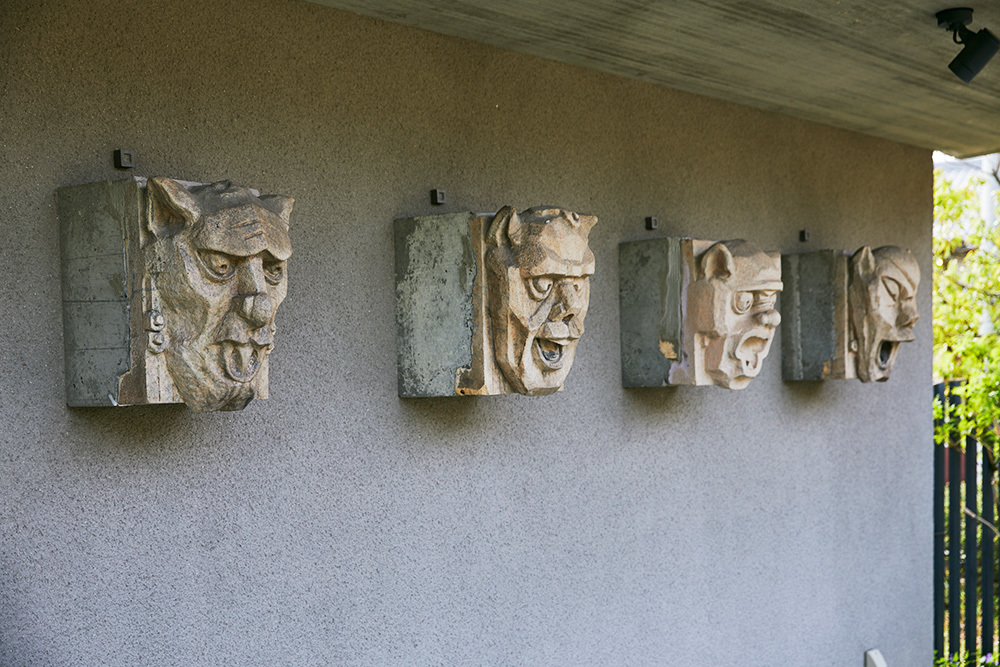
Hands-On Experience Facilities: "Doro-nko Museum" and "Tōraku Workshop"
This INAX Live Museum features two spaces where visitors can experience and feel the appeal of clay and ceramics through hands-on interaction. As venues providing enjoyable opportunities to engage with ceramics, they represent a particular focus within the museum's offerings. One is the "Doro-nko-kan" (Dirt & Mud Hall), which conveys the charm of "clay" – the raw material of ceramics – through both its abundant use in the building's architecture and hands-on workshops, combining physical and experiential elements.
The other is the "Togaku Workshop," where visitors can enjoy "making things" using tiles, such as mosaic art and painting. Here, you can select tiles of your choice from a wide variety of shapes, colors, and textures to create your own tile art piece. These hands-on workshops, through content appealing to both adults and children, create positive encounters with LIXIL as a company and fun memories, contributing to building fans of the corporate brand.
"Ceramic Workshop" ~ Also Conducting Tile Surveys and Restoration for Precious Buildings ~
Beyond exhibitions and experiences, the INAX Live Museum houses facilities dedicated to preserving ceramic techniques and pursuing new creative challenges. The "Ceramic Workshop" undertakes activities to pass on skills to the next generation and explore the future potential of ceramics. This includes restoring and reproducing tiles and terracotta used in historic buildings, as well as collaborating with creators.
This includes tiles from the Church of St. Francis in Milan, Italy, designed by Gio Ponti, often called the father of Italian modern design; red brick tiles from the Marunouchi Station Building of Tokyo Station, a nationally designated Important Cultural Property designed by Kingo Tatsuno, often called the father of modern Japanese architecture; It contributes to preserving valuable architectural culture by participating in the restoration of diverse tiles that adorned these buildings, such as those found in restroom floors and balcony wainscoting. Furthermore, through collaborations with architects and designers, it strives daily to create innovative and cutting-edge ceramics.
"A company is a public asset of society."
October 10th is "Pottery and Light Day," established by Tokoname City. It also marks the anniversary of the passing of INAX founder Chosaburo Ina. Chosaburo served as the first mayor of Tokoname City, formed in 1954 through the merger of four towns and one village. He donated a large portion of his stock holdings to a fund dedicated to the development of Tokoname City and Tokoname ware (the Tokoname City Ceramic Industry and Ceramic Arts Promotion Fund). This commemorative day was established to honor his great achievements, reflect on the history of Tokoname ceramics, pay respect to the accomplishments of our predecessors, and ensure the traditional culture is passed on to future generations. For over 60 years, the fund has been utilized to support the development of ceramics and pottery, including the "Tokoname Ceramic Forest Ceramic Research Institute" and programs for nurturing ceramic artists.
INAX Live Museum conducts various support activities to contribute to Tokoname City, the birthplace of the company and the backbone of its ceramic technology. For the opening of Tokoname City's new city hall in January 2022, the museum supported the creation of scratch tiles symbolizing the pottery town through a citizen-participation workshop. It also provides its museum space annually as the venue for the "Day of Pottery and Light" event. Through such efforts, it is strongly collaborating with the local community, striving to be an open presence connecting people with people and businesses with the community.
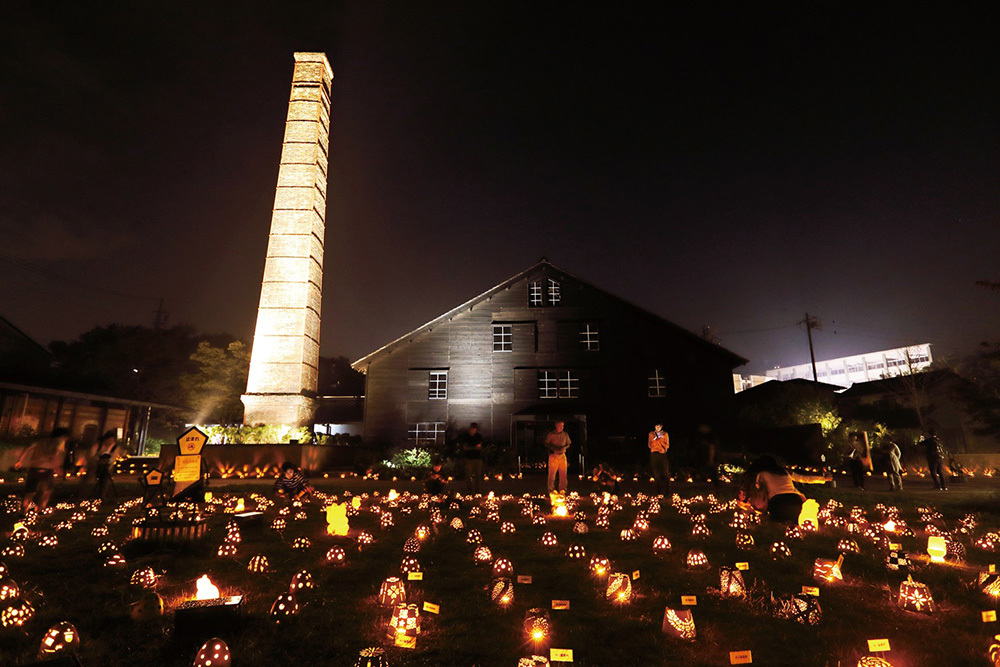
The founder's belief that "a company is a public asset of society" continues to be passed down to future generations through this museum, which actively practices socially conscious activities.
[Editor's Note] (From the Web Dentsu Inc. Editorial Department)
We rarely think about the fact that toilets are made of ceramic. They're just there, taken for granted, used without a second thought. But imagine if they were made of cardboard or plastic—it's horrifying. This is the reality faced by those affected by disasters like earthquakes.
People are obsessed with "taking in." Money, food, everything. But whatever we "take in," we must inevitably release it back out. We forget this. It's the same with garbage problems and everything else. That's where ceramics come in. I thought, "Ah, I see."
Ceramics are gentle to the touch. Strong yet soft. Perhaps it's the earth's bounty. We carefully utilize gifts from the earth found at our feet or on mountainsides, making them useful in our lives. I believe that's the foundation of INAX's corporate mission.
Was this article helpful?
Newsletter registration is here
We select and publish important news every day
For inquiries about this article
Back Numbers
Author

Sakurai Akemi
PR Consulting Dentsu Inc.
Since joining the company, I have been involved in PR planning for a wide range of companies and organizations as a media liaison and sales representative. Currently, I am engaged in new client development, which includes managing seminars and publishing the <a href="https://prx.dentsuprc.co.jp/" target="blank">PRX Magazine</a> newsletter. PRX Magazine|Bringing PR expertise to every business domain|PR Consulting Dentsu Inc. received the Japan PR Association PR Award Grand Prix in 2009 for "Japan Agricultural Products Competition in China" and the Asia-Pacific SABRE Award CSR Category Prize in 2011 for "Spa Resort Hawaiians National Kizuna Caravan." Certified PR Planner by the Japan Public Relations Association.




